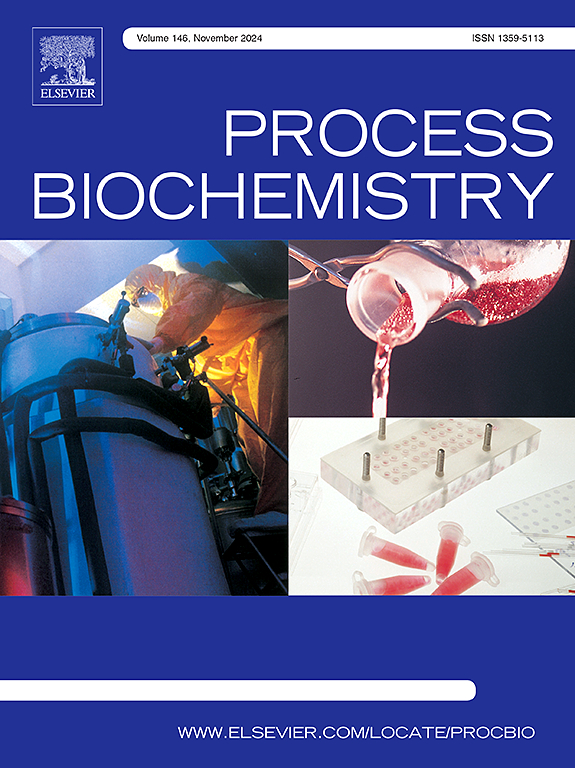Nitrogen removal characteristics and auto-aggregation capacity of the heterotrophic nitrification–aerobic denitrification bacterium, Bacillus amyloliquefaciens N8
IF 4
3区 生物学
Q2 BIOCHEMISTRY & MOLECULAR BIOLOGY
引用次数: 0
Abstract
At present, the main factors restricting the development of high-salinity recirculating aquaculture systems are high costs and the control of inorganic nitrogen pollutants, but only a few studies have reported on salt-tolerant HN-AD strains and their denitrification mechanisms and quantification capabilities. Strain N8 was obtained from seawater biofilter and identified as Bacillus amyloliquefaciens based on the analysis of 16S rRNA gene sequence. Strain N8 has a good ability to remove ammonia nitrogen, nitrite and nitrate at three different concentrations (20, 50, 100 mg L−1) with little accumulation of intermediates, and the maximum removal rate of ammonia nitrogen (50 mg L−1), nitrite (100 mg L−1), and nitrate (100 mg L−1) were 96.56 %, 99.20 % and 90.20 % after 72 h incubation. Through inhibitor and nitrogen balance experiments, it was found that the first step of degradation of ammonia nitrogen by strain N8 was to oxidize it to hydroxylamine, and 72.28 % of ammonia nitrogen and 46.31 % of nitrate nitrogen were eventually converted into intracellular nitrogen. Two denitrification related genes, nirK and nirS, were successfully amplified from strain N8. The ideal conditions for growth and nitrogen removal of strain N8 were sodium succinate as the carbon source, C/N of 20, and salinity between 0 and 30 ‰. Furthermore, the highest auto-aggregation rate of the strain was above 25 % under different nitrogen sources, and the biofilm growth amount of the strain was 3.04 after 24 h culture. All results demonstrate that strain N8 has great practical application potential in nitrogen removal in high-salinity recirculating aquaculture systems.
异养硝化-好氧反硝化细菌解淀粉芽孢杆菌N8的脱氮特性及自聚集能力
目前,制约高盐度循环水养殖系统发展的主要因素是高成本和无机氮污染物的控制,但对耐盐HN-AD菌株及其反硝化机理和量化能力的研究报道较少。菌株N8从海水生物滤池中分离得到,通过16S rRNA基因序列分析鉴定为解淀粉芽孢杆菌。应变N8去除氨氮有很好的能力,在三个不同的亚硝酸盐和硝酸盐浓度(20、50、100 mg L−1)与小中间体,积累和氨氮的最大去除率(50 mg L−1),亚硝酸盐(100 mg L−1),和硝酸(100 mg L−1) % 96.56,99.20 % 90.20 % 72年后 h孵化。通过抑制剂和氮平衡实验发现,菌株N8降解氨氮的第一步是氧化成羟胺,72.28 %的氨氮和46.31 %的硝态氮最终转化为胞内氮。从菌株N8中成功扩增出两个反硝化相关基因nirK和nirS。菌株N8的理想生长脱氮条件为琥珀酸钠为碳源,C/N为20,盐度为0 ~ 30 ‰。在不同氮源条件下,菌株的自聚集率最高可达25 %以上,培养24 h后,菌株的生物膜生长量为3.04。上述结果表明,菌株N8在高盐度循环水养殖系统脱氮方面具有很大的实际应用潜力。
本文章由计算机程序翻译,如有差异,请以英文原文为准。
求助全文
约1分钟内获得全文
求助全文
来源期刊

Process Biochemistry
生物-工程:化工
CiteScore
8.30
自引率
4.50%
发文量
374
审稿时长
53 days
期刊介绍:
Process Biochemistry is an application-orientated research journal devoted to reporting advances with originality and novelty, in the science and technology of the processes involving bioactive molecules and living organisms. These processes concern the production of useful metabolites or materials, or the removal of toxic compounds using tools and methods of current biology and engineering. Its main areas of interest include novel bioprocesses and enabling technologies (such as nanobiotechnology, tissue engineering, directed evolution, metabolic engineering, systems biology, and synthetic biology) applicable in food (nutraceutical), healthcare (medical, pharmaceutical, cosmetic), energy (biofuels), environmental, and biorefinery industries and their underlying biological and engineering principles.
 求助内容:
求助内容: 应助结果提醒方式:
应助结果提醒方式:


